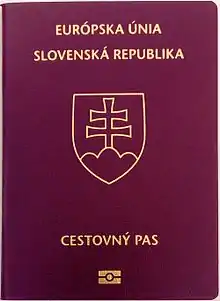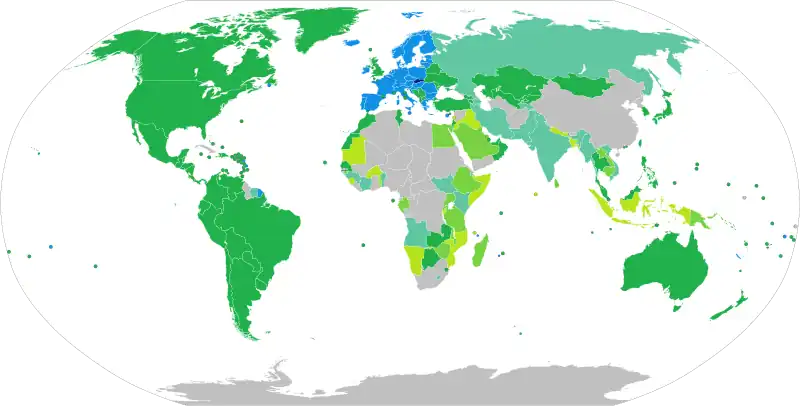Slovak passport
The Slovak passport (Slovak: Slovenský pas) is issued to citizens of Slovakia to enable legal international travel. Every Slovak citizen is also a citizen of the European Union. The passport, along with the national identity card allows for free rights of movement and residence in any of the states of the European Economic Area and Switzerland.
| |
|---|---|
 The front cover of a contemporary Slovak biometric passport. | |
| Type | Passport |
| Issued by | |
| First issued | 1 April 1993 15 January 2008 (biometric passport booklet) 26 November 2014 (current version) |
| Purpose | Identification |
| Eligibility | Slovak citizenship |
| Cost | €33/€66/€99 (16 and over 30/10/2 days); €13/€26/€39 (6 - 16 30/10/2 days); €8/€16/€24 (6 and under 30/10/2 days)[1] |
Every Slovak citizen is entitled to possess two passports of the same kind, if so desired. The second passport is valid for 5 years (instead of the standard 10 years), while the fee remains the same. Passports in Slovakia are issued by the police force.
History
Slovakia started issuing the current biometric passports on 15 January 2008. The biometric data consisted of the face picture. On 22 June 2009 the passports were changed to include second biometric data of the fingerprints. Because of the nature of biometric data acquirement, passports are now issued only directly to the passport owners.[2]
Visa requirements

As of 1 October 2019 Slovak citizens had visa-free or visa on arrival access to 181 countries and territories, ranking the Slovak passport 9th in terms of travel freedom (tied with Australian and Lithuanian passports) according to the Henley Passport Index.[3]
Gallery of historic images
 The non-biometric version issued between 2005 and 2008. The photo was imprinted directly onto the data page. Note that this is a specimen.
The non-biometric version issued between 2005 and 2008. The photo was imprinted directly onto the data page. Note that this is a specimen. The non-biometric version issued between 1994 and 2005. The photo was glued onto the data page, which was then laminated.
The non-biometric version issued between 1994 and 2005. The photo was glued onto the data page, which was then laminated. Slovak passport issued between 1939 and 1945, by the First Slovak Republic.
Slovak passport issued between 1939 and 1945, by the First Slovak Republic.
References
- Správne poplatky
- Cestovné pasy
- "Global Ranking - Passport Index 2019" (PDF). Henley & Partners. Retrieved 1 October 2019.